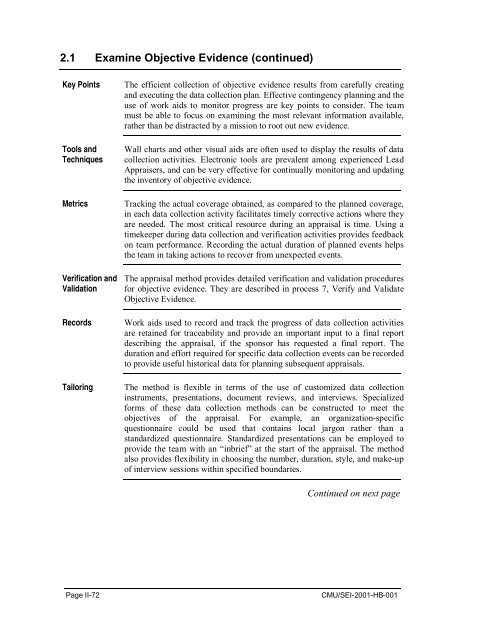Standard CMMI Appraisal Method for Process Improvement (SCAMPI)
Standard CMMI Appraisal Method for Process Improvement (SCAMPI)
Standard CMMI Appraisal Method for Process Improvement (SCAMPI)
Create successful ePaper yourself
Turn your PDF publications into a flip-book with our unique Google optimized e-Paper software.
2.1 Examine Objective Evidence (continued)<br />
Key Points<br />
Tools and<br />
Techniques<br />
Metrics<br />
Verification and<br />
Validation<br />
Records<br />
Tailoring<br />
The efficient collection of objective evidence results from carefully creating<br />
and executing the data collection plan. Effective contingency planning and the<br />
use of work aids to monitor progress are key points to consider. The team<br />
must be able to focus on examining the most relevant in<strong>for</strong>mation available,<br />
rather than be distracted by a mission to root out new evidence.<br />
Wall charts and other visual aids are often used to display the results of data<br />
collection activities. Electronic tools are prevalent among experienced Lead<br />
Appraisers, and can be very effective <strong>for</strong> continually monitoring and updating<br />
the inventory of objective evidence.<br />
Tracking the actual coverage obtained, as compared to the planned coverage,<br />
in each data collection activity facilitates timely corrective actions where they<br />
are needed. The most critical resource during an appraisal is time. Using a<br />
timekeeper during data collection and verification activities provides feedback<br />
on team per<strong>for</strong>mance. Recording the actual duration of planned events helps<br />
the team in taking actions to recover from unexpected events.<br />
The appraisal method provides detailed verification and validation procedures<br />
<strong>for</strong> objective evidence. They are described in process 7, Verify and Validate<br />
Objective Evidence.<br />
Work aids used to record and track the progress of data collection activities<br />
are retained <strong>for</strong> traceability and provide an important input to a final report<br />
describing the appraisal, if the sponsor has requested a final report. The<br />
duration and ef<strong>for</strong>t required <strong>for</strong> specific data collection events can be recorded<br />
to provide useful historical data <strong>for</strong> planning subsequent appraisals.<br />
The method is flexible in terms of the use of customized data collection<br />
instruments, presentations, document reviews, and interviews. Specialized<br />
<strong>for</strong>ms of these data collection methods can be constructed to meet the<br />
objectives of the appraisal. For example, an organization-specific<br />
questionnaire could be used that contains local jargon rather than a<br />
standardized questionnaire. <strong>Standard</strong>ized presentations can be employed to<br />
provide the team with an “inbrief” at the start of the appraisal. The method<br />
also provides flexibility in choosing the number, duration, style, and make-up<br />
of interview sessions within specified boundaries.<br />
Continued on next page<br />
Page II-72<br />
CMU/SEI-2001-HB-001
















